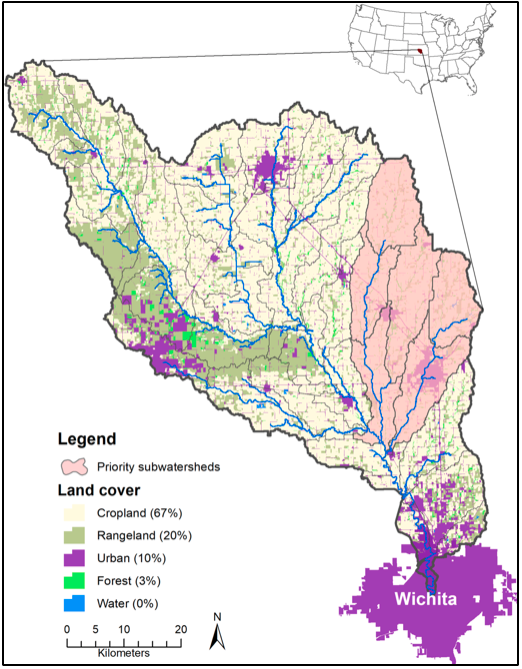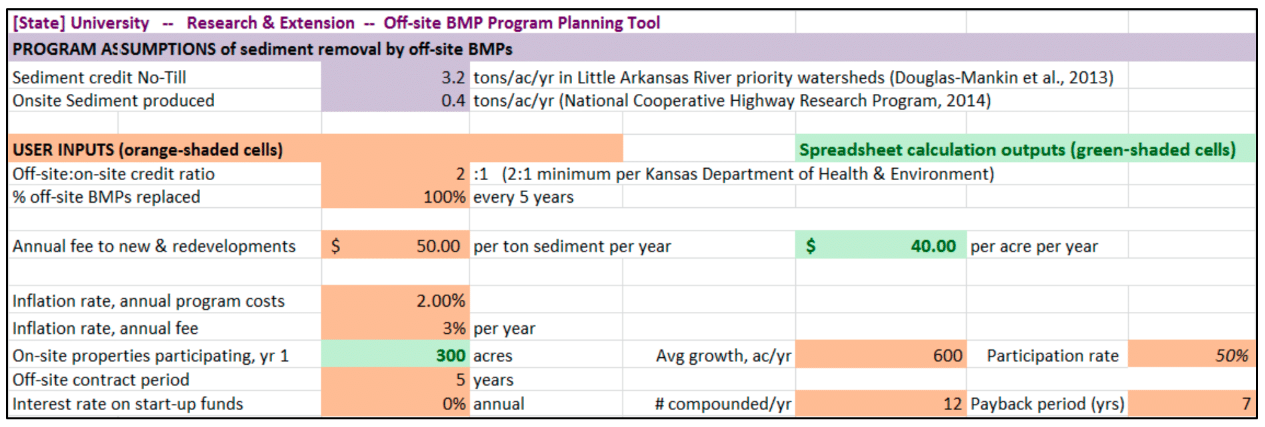 |
February 2019
|
February 2019 // Volume 57 // Number 1 // Ideas at Work // v57-1iw1
Integrating Watershed Management Across the Urban–Rural Interface: Opportunities for Extension Watershed Programs
Abstract
Urban–rural partnerships are increasingly viewed as a critical component of efforts to improve water quality at the watershed scale. We present an opportunity for such partnerships, using an off-site best management practice (BMP) program developed between the City of Wichita and agricultural producers in the Little Arkansas River Watershed of south-central Kansas as an example. We highlight the critical role of Extension specialists in developing this and similar programs, the success of which hinges on targeted BMP implementation and relationships with agricultural producers.
Introduction
Water quality degradation associated with urban and agricultural land uses has driven development of regulations and programs aimed at protecting aquatic ecosystems and their services. For example, urbanized areas in every state in the United States—over 7,550 in total—are required to obtain a municipal separate storm sewer system (MS4) permit to discharge stormwater runoff (Environmental Protection Agency, 2017). Most MS4-permitted urban communities meet permit obligations by requiring entities engaged in new development and redevelopment to implement best management practices (BMPs) to regulate runoff quality and quantity (e.g., Sheshukov, Hutchinson, & Moore, 2017).
Urban and rural entities within the same watershed typically implement water quality programs separately; however, conducting water management along political boundaries may not be the most effective approach. Given the immense task of managing water quality in the country's agricultural heartland, urban–rural partnerships are increasingly viewed as key to addressing watershed-scale water quality issues (Elzufon, 2015). Opportunities for such partnerships include off-site BMP programs between MS4-permitted entities and rural landholders. Off-site BMP programs enable municipalities and developers to pay for water quality BMPs implemented elsewhere in the watershed. If targeted to priority areas for pollutant control, these programs may have a greater watershed-scale impact.
In this article, we explore the potential to integrate water quality efforts of urban and rural watershed stakeholders through an off-site BMP program, using the City of Wichita, Kansas, in the Little Arkansas River (LAR) watershed as an example. Unlike existing off-site programs, which generally require off-site BMPs to be implemented within city jurisdictional boundaries (Center for Watershed Protection, 2012), the LAR watershed–City of Wichita off-site BMP program allows for off-site BMPs implemented by agricultural producers in priority areas of the watershed upstream of the city. Herein we highlight the critical role of Extension specialists in developing and implementing such a program.
LAR Watershed–City of Wichita Off-Site BMP Program
The City of Wichita (population 389,900) is located at the outlet of the predominantly agricultural LAR watershed in south-central Kansas (Figure 1). Per the city's MS4 permit, entities involved with new development and redevelopment sites 1 ac or greater in the city are required to implement water quality BMPs (Figure 2) or to purchase pollutant reduction credits through an off-site BMP program. This off-site BMP program was initiated recently through collaboration by the city; Kansas Department of Health and Environment (KDHE), which administers MS4 permits; and Kansas State University Research and Extension (KSRE).
Figure 1.
The Little Arkansas River Watershed

Figure 2.
Typical On-Site and Off-Site Water Quality Best Management Practices (BMPs) Used by the City of Wichita, Kansas

Note: On-site BMPs include stormwater ponds (left) and hydrodynamic separators (center) (photo credits C. Bohm), whereas no-till (right) is the primary off-site BMP practice (photo credit Natural Resource Conservation Service).
The LAR is a 303(d)-listed stream for sediment impairments; therefore, sediment load was adopted as the common currency of the off-site program. An annual sediment credit fee, paid by urban properties opting to participate in the off-site program, was set to cover the costs of implementing and maintaining off-site BMPs to provide sediment credits at a KDHE-mandated 2:1 ratio; that is, 2 tn of sediment must be retained via off-site BMPs for every 1 tn of sediment generated at the on-site property. Priority areas of the watershed, which were identified through a planning process (Kansas State Research and Extension, 2011), coincide with areas under agricultural production upstream of the city. KSRE played a critical role in identifying the types of off-site BMPs producers would be likely to implement in these areas and in estimating BMP life-cycle costs and sediment trapping efficiencies (Table 1). No-till with intensive crop rotation was identified as an acceptable and effective agricultural BMP in the LAR (e.g., Douglas-Mankin, Daggupati, Sheshukov, & Barnes, 2013), and, therefore, was selected as a model BMP on which to base the sediment credit fee. To address concerns from city officials that producers could decide to discontinue "nonpermanent" BMPs such as no-till (as opposed to permanent BMPs such as conservation easements), thus rendering associated sediment credits void, the sediment credit fee incorporated the cost to replace all no-till acreage every 5 years. To determine the sediment credit fee needed to sustain the program under uncertain program variables (e.g., program participation and off-site BMP replacement rates, program lifetime), KSRE developed a spreadsheet tool that was used by the city to determine an adequate fee (Figure 3).
| BMP type | Life-cycle cost per acrea | Sediment retention rate | Cost per ton life-cycle sediment retainedb |
| Off-site (agricultural) BMPs | |||
| No-till | $40 | 75% | $3.00 |
| Conservation tillage | $20 | 38% | $3.00 |
| Grassed waterways | $160 | 40% | $8.60 |
| Vegetative buffers | $67 | 50% | $7.20 |
| Intensive crop rotations | $20 | 25% | $4.30 |
| Cover crops | $60 | 25% | $43.00 |
| Permanent vegetation | $500 | 95% | $28.30 |
| On-site (urban) BMPs | |||
| Hydrodynamic separator | $28,750 | 50% | $5,425 |
| Pervious pavement | $179,840 | 88% | $19,130 |
| Extended detention basin | $18,465 | 80% | $2,120 |
| Bioretention | $35,500 | 75% | $4,440 |
| Vegetative buffers | $4,500 | 90% | $475 |
| Grass filter strip | $9,600 | 95% | $930 |
| aReported in 2016 $. Life-cycle costs obtained from Roe, Graber, & Schlender (2013) and National Cooperative Highway Research Program (2014) for off-site agricultural and on-site urban BMPs, respectively. bCalculated assuming baseline erosion rates of 1.9 tn sediment ac-1 yr-1 (Tomlinson et al., 2015) and 0.4 tn ac-1 yr-1 (National Cooperative Highway Research Program, 2014) for off-site agricultural and on-site urban BMPs, respectively. | |||
Figure 3.
Spreadsheet Tool for Determining Sediment Credit Fee for New Development and Redevelopment Properties Participating in Off-Site Water Quality Best Management Practices (BMPs) Program

Wichita's off-site BMP program was implemented in August 2016. The city provided the initial capital needed to establish a "bank" of sediment credits, which KSRE soon began dispersing to upstream producers within priority areas of the LAR (see Figure 1) who were recruited to the program to convert conventionally tilled acreage to no-till with intensive crop rotations. The city is responsible for tracking new developments and redevelopments opting to participate in the off-site program and collecting sediment credit fees. KSRE is responsible for recruiting producers to adopt off-site BMPs, administering payments to producers from fees collected by the city to implement off-site BMPs, conducting annual BMP inspections, recruiting new producers to replace failed or abandoned BMPs as necessary, reporting the types and total acreage of off-site BMPs implemented, and estimating sediment load credits provided by off-site BMPs. Wichita provides this information as part of its annual MS4 permit to KDHE. KSRE serves as a critical link between urban and rural stakeholders in this watershed program, and, as demonstrated in other water quality programs (Benham, Braccia, Mostaghimi, Lowery & McClellan, 2007; Bridges, 2010), KSRE's targeted outreach to producers increases the program's likelihood for success.
Outcomes and Opportunities for Extension Programming
The City of Wichita's off-site BMP program could be adapted by MS4-permitted communities elsewhere as a means of integrating water quality management efforts by urban and rural watershed stakeholders. Such programs are most successful when there is some flexibility in the types of BMPs that can be implemented to provide off-site pollutant credits and when the fees collected to pay for those credits match the cost of adopting and maintaining off-site BMPs over the program life cycle. As demonstrated in the program adopted by Wichita, Extension specialists play a critical role in ensuring that these program needs are met by applying their knowledge regarding appropriate BMP types and associated life-cycle costs as well as priority watershed areas. Relationships between Extension specialists and producers also are essential for recruiting producers to implement water quality BMPs in a targeted manner, thus increasing the potential environmental impact of such programs.
Author Note
Author Aleksey Sheshukov is now an associate professor at Kansas State University in Manhattan, Kansas.
Acknowledgments
We thank the City of Wichita staff, including J. Hardesty and J. Hickle, the City of Wichita Stormwater Advisory Board, and S. Schulte for support in program development. Our project was funded by the City of Wichita and Contribution no. 18-209-J from the Kansas Agricultural Experiment Station.
References
Benham, B. L., Braccia, A., Mostaghimi, S., Lowery, J. B., & McClellan, P. W. (2007). Comparison of best management practice adoption between Virginia's Chesapeake Bay Basin and Southern Rivers watersheds. Journal of Extension, 45(2), Article 2RIB3. Available at: https://www.joe.org/joe/2007april/rb3.php
Bridges, C. A. (2010). Watershed-scale dynamics of Tennessee farmland enrollment in the Conservation Reserve Program: Implications for environmental extension. Journal of Extension, 48(2), Article 2IAW4. Available at: https://www.joe.org/joe/2010april/iw4.php
Center for Watershed Protection. (2012, December). Guidance for developing an off-site stormwater compliance program in West Virginia. Retrieved from www.dep.wv.gov/WWE/Programs/stormwater/MS4/permits/Documents/WV_Mitigation-FeeInLieu-Guidance_Final_Jan-2013.pdf
Douglas-Mankin, K., Daggupati, P., Sheshukov, A., & Barnes, P. (2013). Paying for sediment: Field-scale conservation practice targeting, funding, and assessment using the Soil and Water Assessment Tool. Journal of Soil and Water Conservation, 68, 41–51.
Elzufon, B. (2015). Collaborating for healthy watersheds: How the municipal & agricultural sectors are partnering to improve water quality. Retrieved from United State Water Alliance website: http://uswateralliance.org/sites/uswateralliance.org/files/publications/2015-01-30muni_ag_wp_0.pdf
Environmental Protection Agency. (2017, July 21). National Pollutant Discharge Elimination System (NPDES): Stormwater discharges from municipal sources. Retrieved from https://www.epa.gov/npdes/stormwater-discharges-municipal-sources
Kansas State Research and Extension. (2011). Little Arkansas River Watershed restoration and protection strategy—9 element watershed plan. Retrieved from Kansas Watershed Restoration and Protection Strategy website: http://www.kswraps.org/files/attachments/littlearkansas_plansummary.pdf
National Cooperative Highway Research Program. (2014). Long-term performance and life-cycle costs of stormwater best management practices. (Report No. 792). Washington, DC: Transportation Research Board.
Roe, J., Graber, R., & Schlender, R. (2013, November). Purchasing sediment reduction in the Little Ark Watershed. Paper presented to the City of Wichita Stormwater Advisory Board, Wichita, KS.
Sheshukov, A. Y., Hutchinson, S. L., & Moore, T. (2017). Urban water quality BMPs. KSRE Extension Publication (Report No. MF-2732). Retrieved from Kansas State Research and Extension website: https://www.bookstore.ksre.k-state.edu/pubs/MF2732.pdf
Tomlinson, P., Roe, J., Devlin, D., DeRouchey, J., Leatherman, J., Nelson, N., . . . Barnes, P. (2015). Water quality best management practices, effectiveness, and cost for reducing contaminant losses from cropland. (Report No. MF-2572). Retrieved from Kansas State Research and Extension website: https://www.bookstore.ksre.k-state.edu/pubs/MF2572.pdf




